Multidimensional Visual Preferences and Sustainable Management of Heritage Canal Waterfront Landscape Based on Panoramic Image Interpretation
Abstract
:1. Introduction
1.1. Heritage Canals: Cultural Landscapes Integrating Nature and Artifice
1.2. Literature Review on Multidimensional Landscape Visual Preferences
1.3. Panoramic Image Interpretation Technology Based on Deep Learning
1.4. Research Framework
- (1)
- Acquire an objective description of the heritage canal waterfront landscape through continuous, fixed-point panoramic imaging and use image semantic segmentation models to calculate the proportions of various environmental elements and characteristics.
- (2)
- Develop a questionnaire on landscape visual preferences encompassing four perceptual dimensions—aesthetic preference (AP), cultural preference (CP), natural preference (NP), and hydrophilic preference (HP)—to measure public perceptions of the heritage canal waterfront landscape.
- (3)
- Analyse the relationship between the objective environmental characteristics of the heritage canal and landscape visual preferences through a correlation analysis and stepwise multiple regression analysis, identifying environmental elements that explain perceptual results, and compare spatial differences in landscape preferences across different urban canal sections using a non-parametric one-way ANOVA and elucidate the underlying reasons.
- (4)
- Propose strategies for optimising and enhancing the quality of the waterfront landscape of heritage canals, effectively guiding the planning, design, and sustainable management of the heritage canal environment, improving landscape outcomes, and promoting the multifaceted value of heritage canals.
2. Materials and Methods
2.1. Study Area
2.2. Research Methods
2.2.1. Data Collection: Panoramic Image Capture
2.2.2. Environmental Feature Identification: Image Semantic Segmentation and Environmental Feature Indicator Calculation
2.2.3. Landscape Preference Evaluation
2.2.4. Statistical Analysis
3. Results
3.1. Descriptive Statistics of Environmental Characteristics and Landscape Visual Preferences
3.1.1. Descriptive Statistics of Environmental Segmentation Element Ratios
3.1.2. Descriptive Statistics of Landscape Visual Preference Scores
3.2. Relationship Between Environmental Characteristics and Landscape Visual Preferences
3.2.1. Correlation Analysis
3.2.2. Stepwise Multiple Regression
3.3. Differences in Landscape Preferences Across Different Segments
4. Discussion
4.1. Factors Influencing Visual Preferences for Heritage Canal Waterfront Landscapes
4.1.1. Relationships Among Landscape Visual Preferences
4.1.2. Environmental Factors Influencing Landscape Visual Preferences
- (1)
- The factors explaining aesthetic preference include the interference degree (ID), river visibility ratio (RVR), green visibility ratio (GVR), cultural facility density (CFD), and pavement quality (PQ). This indicates that landscape aesthetics involve a complex perceptual process. Increases in blue-green spaces such as waterbodies and vegetation significantly enhance aesthetic inclination value, aligning with findings from numerous previous studies [54,55]. The visibility and strategic positioning of waterbodies, as critical elements of canal waterfront landscapes, contribute positively to visual aesthetic experiences [56,57]. Additionally, natural plant landscapes composed of trees and lawns also promote aesthetic functionality [58,59]. This is similar to the results of a green view index (GVI) analysis of street landscapes [39]. Studies have shown that when the GVI exceeds 15%, people tend to feel comfortable, and a GVI above 30% may lead to a richer impression of greenery [60]. In contrast, some prior studies suggested that artificial structures negatively affect aesthetic preference [48], whereas this research found that cultural structures and landscape facilities (e.g., seating, streetlamps) and high-quality pavements can enhance aesthetic preference to a certain extent. This may be because these well-designed cultural elements achieve a good visual balance with the natural scenery, thereby stimulating the perception of beauty. This can be confirmed through urban river improvement projects such as the Chicago Riverside Trail in the United States and the Cheonggye River in South Korea [61,62], indicating that the aesthetic orientation of heritage canals results from harmonious consideration of both natural and artificial elements.
- (2)
- Cultural preference is the most unique and significant aspect of landscape perception for heritage canals. With abundant cultural heritage resources such as hydraulic structures, navigation channels, and ancient buildings, cultural significance distinguishes these canals from typical urban rivers. This study found that cultural preference for heritage canal landscapes is primarily influenced by cultural facility density (CFD), the river visibility ratio (RVR), the interference degree (ID), the waterfront enclosure degree (WED), and the bare land ratio (BLR). An increase in cultural facility density and river visibility significantly enhances cultural perception, likely due to the forms of cultural facilities, ancient buildings, and canal water that evoke historical cultural sentiments [63]. The Amsterdam Canal in Netherlands combines landscape architecture with historical and cultural significance, which enriches people’s enjoyment and connection with the environment [7,64]. However, higher disturbance, waterfront enclosure area, and bare land ratios can diminish cultural perception. It is noteworthy that cultural preference scored the lowest among the four indicators, indicating a generally weak cultural perception of the Yangzhou canal waterfront landscape, which requires targeted improvement.
- (3)
- Natural preference is also an important indicator for measuring canal landscape preferences. This study revealed that natural preference is primarily related to the green visibility ratio (GVR), modern construction density (MCD), and street openness (SO). Abundant vegetation is the most critical factor influencing natural perception. Many studies have confirmed that increased plant density can significantly enhance respondents’ landscape preferences [65,66]. However, an increase in grey artificial structures, such as modern constructions, large bridges, and road squares, significantly reduces natural perception and can impact aesthetic experiences. This may be because the introduction of artificial structures reduces the proportion of natural vegetation, which has also been confirmed in studies related to park green spaces [48].
- (4)
- Hydrophilic preference serves as an important indicator for measuring the public’s experience and interaction with waterfront landscapes. This study indicated that hydrophilic preference is influenced by the river visibility ratio (RVR), the waterfront enclosure degree (WED), the green visibility ratio (GVR), water quality (WQ), pavement quality (PQ), and the sky visibility ratio (SVR). Larger water surface areas and reduced enclosure can significantly enhance hydrophilicity. Additionally, water quality and pavement quality are crucial factors affecting hydrophilic experiences; clear water and high-quality waterfront pavements are more inviting than murky water and cluttered surfaces. This aligns with previous findings that high-quality river landscapes enhance the overall enjoyment and visual pleasure derived from the surrounding environment [67], encouraging proximity to waterbodies.
4.2. Spatial Differences in Visual Preferences for Canal Waterfront Landscapes Across Different Urban Segments in Urban Areas
4.3. Recommendations for Optimising Planning and Sustainable Management of Heritage Canal Waterfront Landscapes
4.3.1. Enhancing Waterfront Landscape Quality Through Coordination of Blue-Green Natural and Artificial Elements
4.3.2. Highlighting Historical and Cultural Aspects of the Canal Through Heritage Feature Excavation and Waterfront Space Transformation
4.3.3. Balancing Landscape Quality Disparities Across Different Urban Areas Through Greenway Connectivity and Resource Integration
5. Conclusions
Author Contributions
Funding
Data Availability Statement
Acknowledgments
Conflicts of Interest
References
- ReferencesGarau, E.; Torralba, M.; Pueyo-Ros, J. What is a river basin? Assessing and understanding the sociocultural mental constructs of landscapes from different stakeholders across a river basin. Landsc. Urban Plan. 2021, 214, 104192. [Google Scholar] [CrossRef]
- Guo, Y.; Fu, B.; Wang, Y.; Xu, P.; Liu, Q. Identifying spatial mismatches between the supply and demand of recreation services for sustainable urban river management: A case study of Jinjiang River in Chengdu, China. Sustain. Cities Soc. 2022, 77, 103547. [Google Scholar] [CrossRef]
- Donohoe, H.M. Sustainable heritage tourism marketing and Canada’s Rideau Canal world heritage site. J. Sustain. Tour. 2012, 20, 121–142. [Google Scholar] [CrossRef]
- Frenkel, S. Geographical representations of the «Other»: The landscape of the Panama Canal Zone. J. Hist. Geogr. 2002, 28, 85–99. [Google Scholar] [CrossRef]
- Simon, A. Mixing Water and Culture: Making the Canal Landscape in Phoenix; Arizona State University: Tempe, AZ, USA, 2002. [Google Scholar]
- Won, K.J. The Rise and Decline of Britain’s Canal System: With Special References to the Birmingham Canal Navigations. Sa-Chong 2009, 69, 59–86. [Google Scholar]
- Varady, D.P. Amsterdam’s Canal District: Origins, evolution, and future prospects. J. Urban Aff. 2021, 43, 1050–1051. [Google Scholar] [CrossRef]
- Tang, L.A.; Jang, S.C. The Evolution from Transportation to Tourism: The Case of the New York Canal System. Tour. Geogr. 2010, 12, 435–459. [Google Scholar] [CrossRef]
- Machar, I. The effect of landscape character change on the recreation function of a water management construction in the landscape case study: Bata canal, south moravia (czech republic). In Proceedings of the Conference on Public Recreation and Landscape Protection—With Man Hand in Hand, Mendel Univ, Fac Forestry & Wood Technol, Dept Landscape Management, Brno, Czech Republic, 1–3 May 2013; pp. 190–195. [Google Scholar]
- Zhang, S.Y.; Yu, W.T. Canal Heritage Tourism Utilization Models: Experience and Inspirations from the Grand Canal (Beijing Section). Land 2024, 13, 860. [Google Scholar] [CrossRef]
- Millman, Z.K. Landscape Narratives and the Construction of Meaning in the Contemporary Urban Canal-Scape; Birmingham City University: England, UK, 2012. [Google Scholar]
- Sigley, G.; An, Z.; Song, C.; Su, X. Cultural route heritage as mobility narrative: The world heritage inscription of China’s Grand Canal. Int. J. Herit. Stud. 2024, 30, 997–1009. [Google Scholar] [CrossRef]
- Cai, J.; Peng, J. Introduction of Beijing-Hangzhou Grand Canal and analysis of its heritage values. J. Hydro-Environ. Res. 2019, 26, 2–7. [Google Scholar] [CrossRef]
- Tang, F.; Wang, L.; Guo, Y.; Fu, M.; Huang, N.; Duan, W.; Luo, M.; Zhang, J.; Li, W.; Song, W. Spatio-temporal variation and coupling coordination relationship between urbanisation and habitat quality in the Grand Canal, China. Land Use Policy 2022, 117, 106119. [Google Scholar] [CrossRef]
- Jiang, A.; Sun, F.; Zhang, B.; Wu, Q.; Cai, S.; Yang, Z.; Chang, Y.; Han, R.; Yu, S. Spatiotemporal dynamics and driving factors of vegetation coverage around linear cultural heritage: A case study of the Beijing-Hangzhou Grand Canal. J. Environ. Manag. 2024, 349, 119431. [Google Scholar] [CrossRef]
- De Val, G.D.L.F.; Mühlhauser, H.J.U.F.; Greening, U. Visual quality: An examination of a South American Mediterranean landscape, Andean foothills east of Santiago (Chile). Urban For. Urban Green. 2014, 13, 261–271. [Google Scholar] [CrossRef]
- Jeon, J.Y.; Jo, H.I. Effects of audio-visual interactions on soundscape and landscape perception and their influence on satisfaction with the urban environment. Build. Environ. 2020, 169, 106544. [Google Scholar] [CrossRef]
- Rock, I.; Harris, C.S. Vision and touch. Sci. Am. 1967, 216, 96–104. [Google Scholar] [CrossRef] [PubMed]
- Jovanovska, D.; Ruth, S.D.; Fiona, T.S.; Lj, M.J.L.E. Assessing the landscape visual quality of Shar Planina, North Macedonia. Landsc. Ecol. 2020, 35, 2805–2823. [Google Scholar] [CrossRef]
- Kalivoda, O.; Vojar, J.; Skřivanová, Z.; Zahradník, D. Consensus in landscape preference judgments: The effects of landscape visual aesthetic quality and respondents’ characteristics. J. Environ. Manag. 2014, 137, 36–44. [Google Scholar] [CrossRef]
- Xie, B.; Pang, Z.; He, D.; Lu, Y.; Chen, Y. Effects of neighborhood environment on different aspects of greenway use: Evidence from East Lake Greenway, China. J. Transp. Geogr. 2023, 106, 103488. [Google Scholar] [CrossRef]
- Fang, Y.-N.; Tian, J.; Namaiti, A.; Zhang, S.; Zeng, J.; Zhu, X. Visual aesthetic quality assessment of the streetscape from the perspective of landscape-perception coupling. Environ. Impact Assess. Rev. 2024, 106, 107535. [Google Scholar] [CrossRef]
- Liu, W.; Hu, X.; Song, Z.; Yuan, X. Identifying the integrated visual characteristics of greenway landscape: A focus on human perception. Sustain. Cities Soc. 2023, 99, 104937. [Google Scholar] [CrossRef]
- Li, X.; Wang, X.; Jiang, X.; Han, J.; Wang, Z.; Wu, D.; Lin, Q.; Li, L.; Zhang, S.; Dong, Y. Prediction of riverside greenway landscape aesthetic quality of urban canalized rivers using environmental modeling. J. Clean. Prod. 2022, 367, 133066. [Google Scholar] [CrossRef]
- Luo, S.; Xie, J.; Furuya, K.J.L. Assessing the Preference and Restorative Potential of Urban Park Blue Space. Land 2021, 10, 1233. [Google Scholar] [CrossRef]
- Clark, N.E.; Lovell, R.; Wheeler, B.W.; Higgins, S.L.; Depledge, M.H.; Norris, K. Evolution. Biodiversity, cultural pathways, and human health: A framework. Trends Ecol. Evol. 2014, 29, 198–204. [Google Scholar] [CrossRef] [PubMed]
- Luo, S.; Xie, J.; Furuya, K. Effects of perceived physical and aesthetic quality of urban blue spaces on user preferences–A case study of three urban blue spaces in Japan. Heliyon 2023, 9, e15033. [Google Scholar] [CrossRef] [PubMed]
- Subiza-Pérez, M.; Hauru, K.; Korpela, K.; Haapala, A.; Lehvävirta, S. Perceived Environmental Aesthetic Qualities Scale (PEAQS)—A self-report tool for the evaluation of green-blue spaces. Urban For. Urban Green. 2019, 43, 126383. [Google Scholar] [CrossRef]
- Zhang, J.; Li, D.; Ning, S.; Furuya, K. Sustainable Urban Green Blue Space (UGBS) and Public Participation: Integrating Multisensory Landscape Perception from Online Reviews. Land 2023, 12, 1360. [Google Scholar] [CrossRef]
- Chen, C.; Luo, W.; Li, H.; Zhang, D.; Xia, Y.; Health, P. Impact of Perception of Green Space for Health Promotion on Willingness to Use Parks and Actual Use among Young Urban Residents. Int. J. Environ. Res. Public Heal. 2020, 17, 5560. [Google Scholar] [CrossRef]
- Kaltenborn, B.R.P.; Bjerke, T.J.L.; Planning, U. Associations between environmental value orientations and landscape preferences. Landsc. Urban Plan. 2002, 59, 1–11. [Google Scholar] [CrossRef]
- Arriaza, M.; Caas-Ortega, J.F.; Caas-Madueo, J.A.; Ruiz-Aviles, P.J.L.; Planning, U. Assessing the visual quality of rural landscapes. Landsc. Urban Plan. 2004, 69, 115–125. [Google Scholar] [CrossRef]
- Bishop, I.D.; Rohrmann, B. Subjective responses to simulated and real environments: A comparison. Landsc. Urban Plan. 2003, 65, 261–277. [Google Scholar] [CrossRef]
- Zhang, L.-M.; Zhang, R.-X.; Jeng, T.-S.; Zeng, Z.-Y. Cityscape protection using VR and eye tracking technology. J. Vis. Commun. Image Represent. 2019, 64, 102639. [Google Scholar] [CrossRef]
- Nagata, S.; Nakaya, T.; Hanibuchi, T.; Amagasa, S.; Kikuchi, H.; Inoue, S. Objective scoring of streetscape walkability related to leisure walking: Statistical modeling approach with semantic segmentation of Google Street View images. Health Place 2020, 66, 102428. [Google Scholar] [CrossRef]
- Wang, J.; Liu, W.; Gou, A. Numerical characteristics and spatial distribution of panoramic Street Green View index based on SegNet semantic segmentation in Savannah. Urban For. Urban Green. 2022, 69, 127488. [Google Scholar] [CrossRef]
- Aikoh, T.; Homma, R.; Abe, Y. Comparing conventional manual measurement of the green view index with modern automatic methods using google street view and semantic segmentation. Urban For. Urban Green. 2023, 80, 127845. [Google Scholar] [CrossRef]
- Lee, S.; Son, Y. Mapping of user-perceived landscape types and spatial distribution using crowdsourced photo data and machine learning: Focusing on Taeanhaean National Park. J. Outdoor Recreat. Tour. 2023, 44, 100616. [Google Scholar] [CrossRef]
- Zhang, F.; Zhou, B.; Liu, L.; Liu, Y.; Fung, H.H.; Lin, H.; Ratti, C. Measuring human perceptions of a large-scale urban region using machine learning. Landsc. Urban Plan. 2018, 180, 148–160. [Google Scholar] [CrossRef]
- Luo, J.; Zhao, T.; Cao, L.; Biljecki, F. Semantic Riverscapes: Perception and evaluation of linear landscapes from oblique imagery using computer vision. Landsc. Urban Plan. 2022, 228, 104569. [Google Scholar] [CrossRef]
- Chesnokova, O.; Purves, R.S. From image descriptions to perceived sounds and sources in landscape: Analyzing aural experience through text. Appl. Geogr. 2018, 93, 103–111. [Google Scholar] [CrossRef]
- Sun, Y.; Hao, Z.; Chang, H.; Yang, J.; Ding, G.; Guo, Z.; He, X.; Huang, J. Accurate mapping of rapeseed fields in the initial flowering stage using Sentinel-2 satellite images and convolutional neural networks. Ecol. Indic. 2024, 162, 112027. [Google Scholar] [CrossRef]
- Yang, J.; Matsushita, B.; Zhang, H. Improving building rooftop segmentation accuracy through the optimization of UNet basic elements and image foreground-background balance. ISPRS J. Photogramm. Remote Sens. 2023, 201, 123–137. [Google Scholar] [CrossRef]
- Xie, E.; Wang, W.; Yu, Z.; Anandkumar, A.; Alvarez, J.M.; Luo, P. SegFormer: Simple and Efficient Design for Semantic Segmentation with Transformers. Adv. Neural Inf. Process. Syst. 2021, 34, 12077–12090. [Google Scholar]
- Navarrete-Hernandez, P.; Laffan, K. A greener urban environment: Designing green infrastructure interventions to promote citizens’ subjective wellbeing. Landsc. Urban Plan. 2019, 191, 103618. [Google Scholar] [CrossRef]
- Li, Y.W.; Qiu, B. Using Deep Learning Approaches to Quantify Landscape Preference of the Chinese Grand Canal: An Empirical Case Study of the Yangzhou Ancient Canal. Sustainability 2024, 16, 3602. [Google Scholar] [CrossRef]
- Wang, X.; Han, F. Reconnect the City of Yangzhou with World Heritage Grand Canal Landscape. In Proceedings of the Proceedings of the 51st Isocarp Congress, Rotterdam, The Netherlands, 19–23 October 2015. [Google Scholar]
- Gungor, S.; Polat, A.T. Relationship between visual quality and landscape characteristics in urban parks. J. Environ. Prot. Ecol. 2018, 19, 939–948. [Google Scholar]
- Li, J.; Huang, Z.; Zheng, D.; Zhao, Y.; Huang, P.; Huang, S.; Fang, W.; Fu, W.; Zhu, Z. Effect of Landscape Elements on Public Psychology in Urban Park Waterfront Green Space: A Quantitative Study by Semantic Segmentation. Forests 2023, 14, 244. [Google Scholar] [CrossRef]
- Jahani, A.; Allahverdi, S.; Saffariha, M.; Alitavoli, A.; Ghiyasi, S. Environmental modeling of landscape aesthetic value in natural urban parks using artificial neural network technique. Model. Earth Syst. Environ. 2022, 8, 163–172. [Google Scholar] [CrossRef]
- Xu, D.; Li, Y.J.C.L.A. Experts and public aesthetic differences based on SD-SBE method. Chin. Landsc. Archit. 2014, 30, 52–56. [Google Scholar]
- Li, J.; Huang, Z.; Zhu, Z.; Ding, G. Coexistence Perspectives: Exploring the impact of landscape features on aesthetic and recreational values in urban parks. Ecol. Indic. 2024, 162, 112043. [Google Scholar] [CrossRef]
- Zhang, W.; Zeng, H. Spatial differentiation characteristics and influencing factors of the green view index in urban areas based on street view images: A case study of Futian District, Shenzhen, China. Urban For. Urban Green. 2024, 93, 128219. [Google Scholar] [CrossRef]
- Xia, Y.; Yabuki, N.; Fukuda, T. Development of a system for assessing the quality of urban street-level greenery using street view images and deep learning. Urban For. Urban Green. 2021, 59, 126995. [Google Scholar] [CrossRef]
- Yu, X.; Qi, W. Measuring vegetation greenery in park using iPhone panoramic image and a new green vegetation extraction index. Urban For. Urban Green. 2021, 65, 127310. [Google Scholar] [CrossRef]
- Kaplan, R.; Herbert, E.J. Cultural and sub-cultural comparisons in preferences for natural settings. Landsc. Urban Plan. 1987, 14, 281–293. [Google Scholar] [CrossRef]
- Petrova, E.G.; Mironov, Y.V.; Aoki, Y.; Matsushima, H.; Ebine, S.; Furuya, K.; Petrova, A.; Takayama, N.; Ueda, H.; Science, P. Comparing the visual perception and aesthetic evaluation of natural landscapes in Russia and Japan: Cultural and environmental factors. Prog. Earth Planet. Sci. 2015, 2, 6. [Google Scholar] [CrossRef]
- Santosa, H.; Ernawati, J.; Wulandari, L.D. Visual quality evaluation of urban commercial streetscape for the development of landscape visual planning system in provincial street corridors in Malang, Indonesia. IOP Conf. Series: Earth Environ. Sci. 2018, 126, 01220. [Google Scholar] [CrossRef]
- Fumagalli, N.; Maccarini, M.; Rovelli, R.; Berto, R.; Senes, G. An Exploratory Study of Users’ Preference for Different Planting Combinations along Rural Greenways. Sustainability 2020, 12, 2120. [Google Scholar] [CrossRef]
- Li, X.; Zhang, C.; Li, W.; Ricard, R.; Meng, Q.; Zhang, W. Assessing street-level urban greenery using Google Street View and a modified green view index. Urban For. Urban Green. 2015, 14, 675–685. [Google Scholar] [CrossRef]
- Al-Kodmany, K. Chapter 2—Reviving aging cities’ infrastructure: The case of riverfronts. In Progress in Sustainable Development; Ting, D., O’Brien, P., Eds.; Elsevier: Amsterdam, The Netherlands, 2023; pp. 55–72. [Google Scholar] [CrossRef]
- Woo, H. Trends in ecological river engineering in Korea. J. Hydro-Environ. Res. 2010, 4, 269–278. [Google Scholar] [CrossRef]
- Zhou, L.; Zhao, Y.; Yang, X.; He, J.; Wang, H. Identification of important terraced visual landscapes based on a sensitivity-subjectivity preference matrix for agricultural cultural heritage in the southwestern china. Ecol. Indic. 2023, 154, 110573. [Google Scholar] [CrossRef]
- Song, Y.; Yang, R.; Lu, H.; Fernandez, J.; Wang, T. Why do we love the high line? A case study of understanding long-term user experiences of urban greenways. Comput. Urban Sci. 2023, 3, 18. [Google Scholar] [CrossRef]
- Polat, A.T.; Akay, A. Relationships between the visual preferences of urban recreation area users and various landscape design elements. Urban For. Urban Green. 2015, 14, 573–582. [Google Scholar] [CrossRef]
- Sharafatmandrad, M.; Mashizi, A.K.J.E.e. Visual value of rangeland landscapes: A study based on structural equation modeling. Ecol. Eng. 2020, 146, 105742. [Google Scholar] [CrossRef]
- Fan, R.; Yocom, K.P.; Guo, Y. Utilizing Fractal Dimensions as Indicators to Detect Elements of Visual Attraction: A Case Study of the Greenway along Lake Taihu, China. Land 2023, 12, 883. [Google Scholar] [CrossRef]
- Meng, C.; Chen, Y.; Yang, J.; Su, X.; Guo, W.; Zhang, K. Association between multilevel landscape characteristics and rural sustainability: A case study of the water-net region in the Yangtze River Delta, China. Ecol. Inform. 2024, 82, 102677. [Google Scholar] [CrossRef]
- Zhang, W.; Su, Y. Perception study of urban green spaces in Singapore urban parks: Spatio-temporal evaluation and the relationship with land cover. Urban For. Urban Green. 2024, 99, 128455. [Google Scholar] [CrossRef]

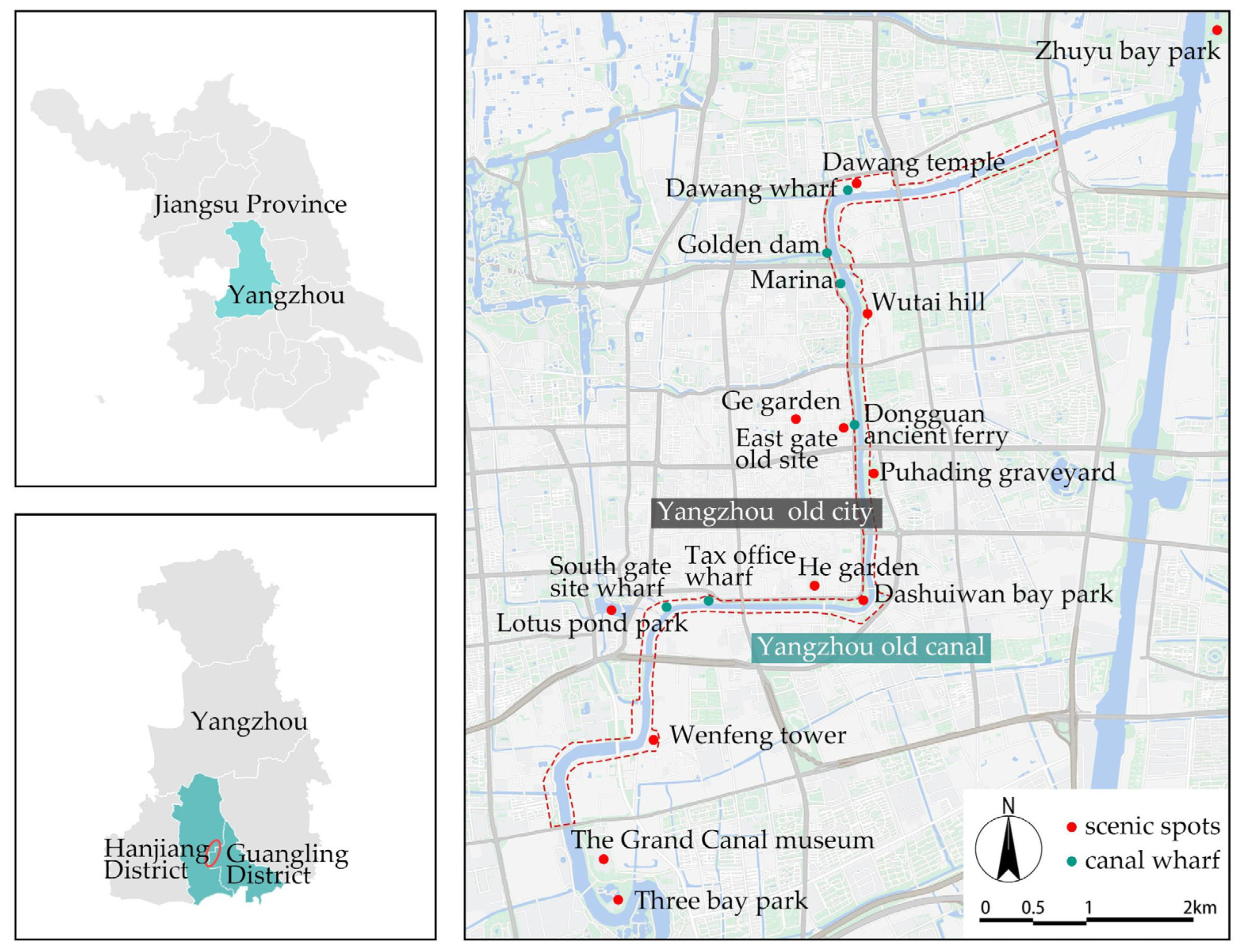
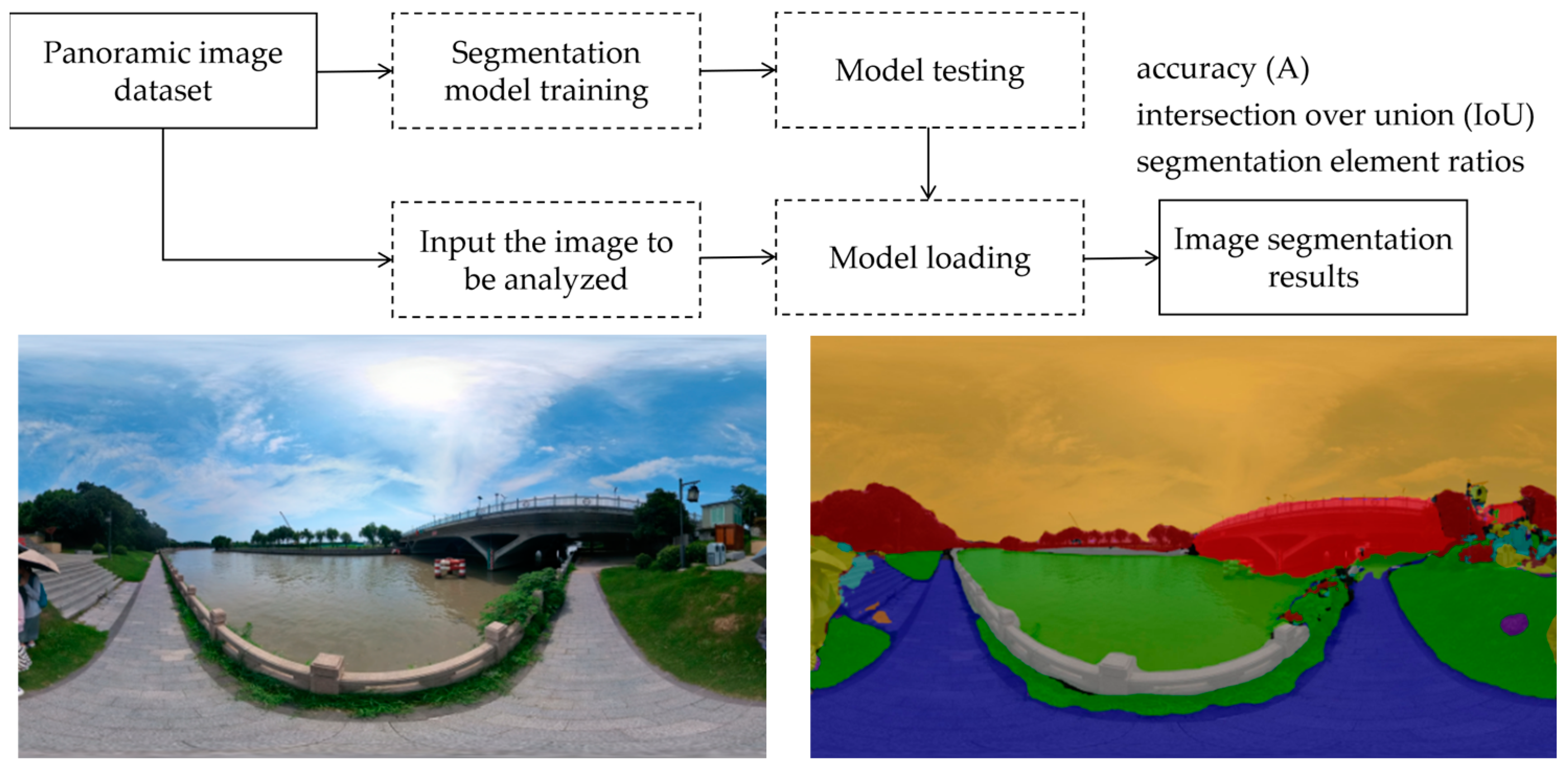
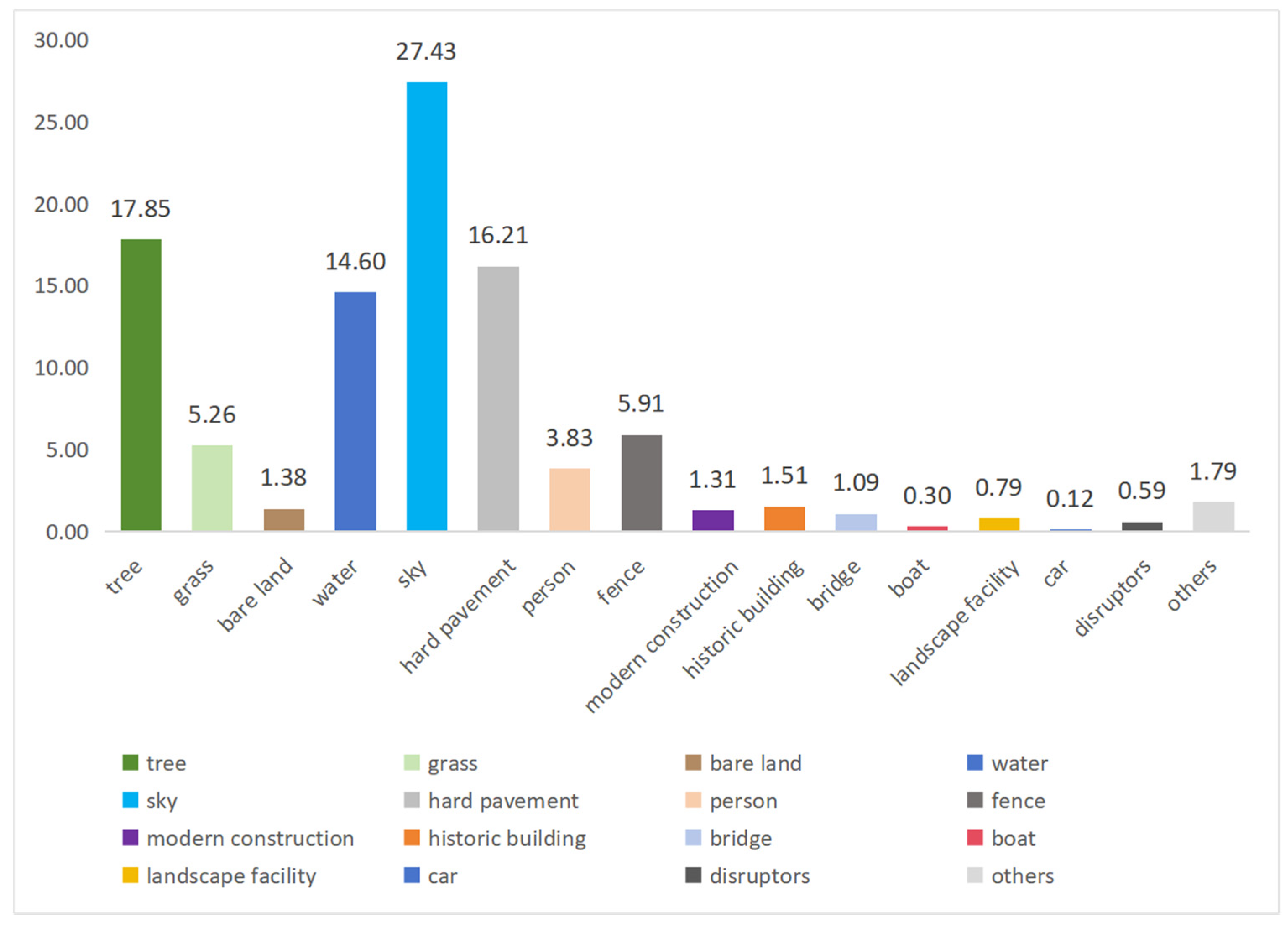
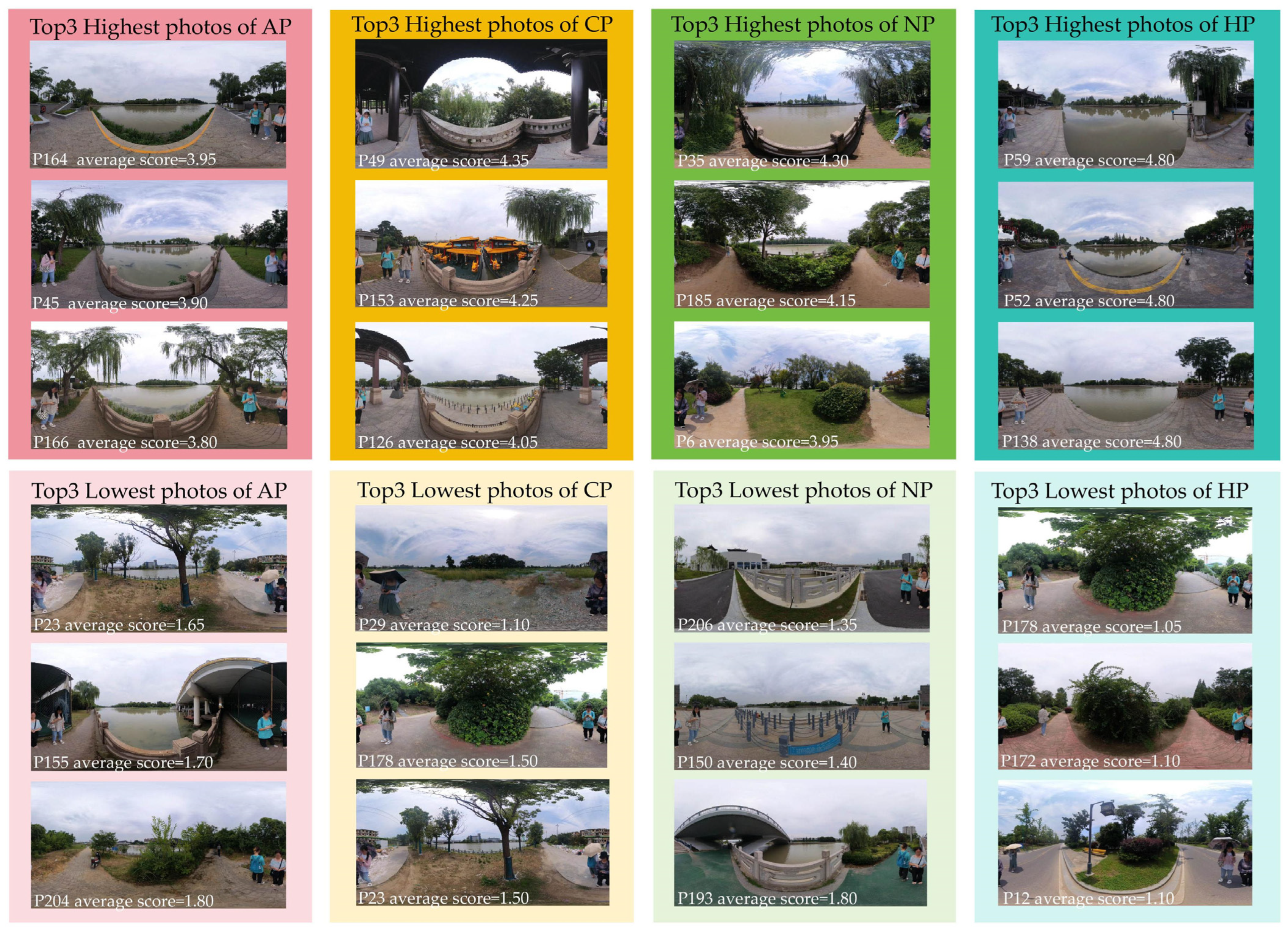
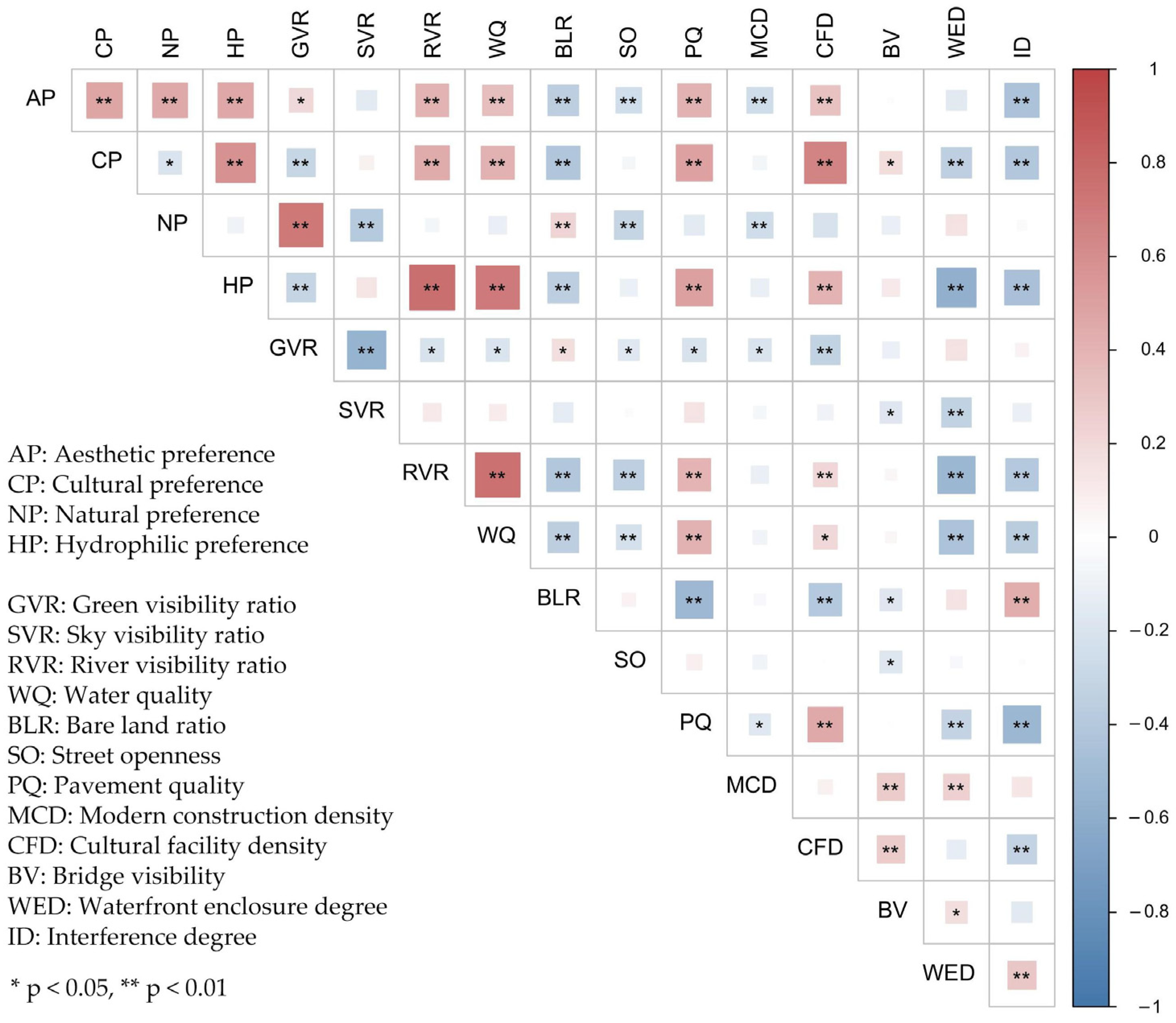


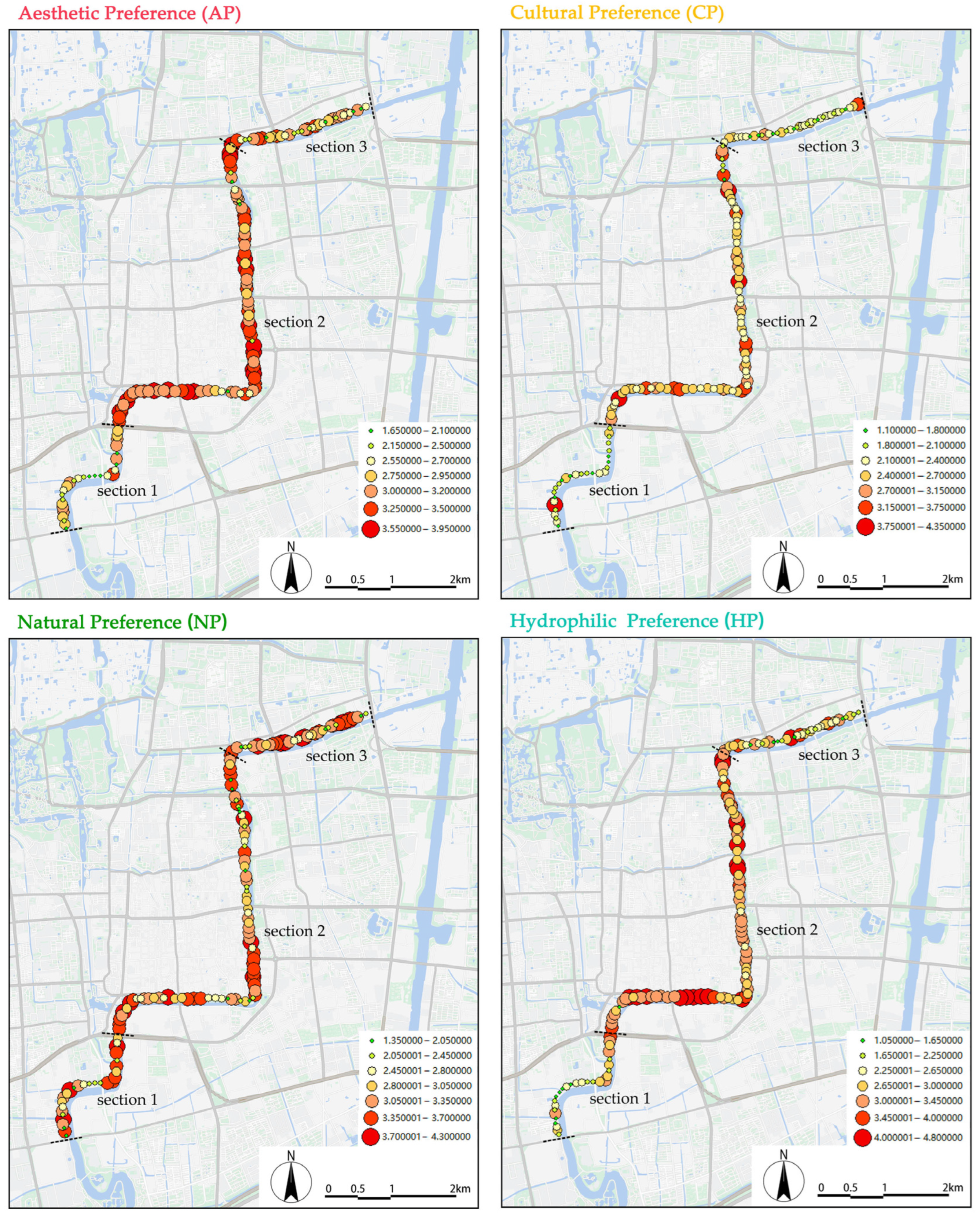
| No. | Category | Code |
|---|---|---|
| 1 | tree | At,n |
| 2 | grass | Ag,n |
| 3 | bare land | Abl,n |
| 4 | water | Aw,n |
| 5 | sky | As,n |
| 6 | hard pavement | Ahp,n |
| 7 | person | Ap,n |
| 8 | fence | Af,n |
| 9 | modern construction | Amc,n |
| 10 | historic building | Ahb,n |
| 11 | bridge | Abr,n |
| 12 | car | Ac,n |
| 13 | boat | Abo,n |
| 14 | landscape facility | Alf,n |
| 15 | disruptors | Ad,n |
| 16 | others | Ao,n |
| Type | No. | Index Item | Indicator Selection Basis | Index Calculation |
|---|---|---|---|---|
| Blue-green: nature- and water-related indicators | 1 | Green visibility ratio (GVR) | The proportion of green plants in people’s view emphasises the three-dimensional visual effect of greening. | At,n + Ag,n |
| 2 | Sky visibility ratio (SVR) | The proportion of sky in what people see with their eyes emphasises the visual effect of sky visibility. | As,n | |
| 3 | River visibility ratio (RVR) | The proportion of waterbodies in what people see with their eyes emphasises the visual effect of water visibility. | Aw,n | |
| 4 | Water quality (WQ) | Water quality has an impact on people’s perception of hydrophilicity and aesthetics. | 5-level rating | |
| 5 | Bare land ratio (BLR) | The proportion of bare ground in the picture reflects the degree of bare ground. | Abl,n | |
| Grey: artificial construction indicators | 6 | Street openness (SO) | The proportion of hard paved streets and roads in the images people see reflects the degree of openness of urban streets. | Ahp,n |
| 7 | Pavement quality (PQ) | The quality of hard pavement affects people’s evaluation of landscape quality. | 5-level rating | |
| 8 | Modern construction density (MCD) | The proportion of modern architecture that people see with their eyes emphasises the degree of engineering construction. | Amc,n | |
| 9 | Cultural facility density (CFD) | The proportion of cultural buildings and related constructions (such as historic buildings, boats, streetlights, etc.) has an impact on cultural perception. | Ahb,n + Abo,n + Alf,n | |
| 10 | Bridge visibility (BV) | The existence of bridges affects the linear spatial pattern of canals, and the proportion of bridges in people’s view affects the visual effect of the landscape. | Abr,n | |
| 11 | Waterfront enclosure degree (WED) | The proportion of riverbank enclosures in the picture affects people’s perception of security and hydrophilicity. | Af,n | |
| 12 | Interference degree (ID) | This is the overall visual proportion of obstacles, piled-up debris, garbage, pipelines, cars, etc. | Ad,n + Ac,n |
| Factors | Survey Questions | level |
|---|---|---|
| Aesthetic preference (AP) | Do you think the scenery here is beautiful? | 1–5 |
| Cultural preference (CP) | Do you think this place reflects the historical and cultural heritage of the canal? | 1–5 |
| Natural preference (NP) | Do you think this place is natural? | 1–5 |
| Hydrophilic preference (HP) | Do you think it’s easy to access water here? | 1–5 |
| Information | Proportion |
|---|---|
| gender | Male (47.5%), female (52.5%) |
| age | 20–25 (35%), 26–30 (51.25%), 31–35 (13.75%) |
| occupation | undergraduates (22.5%), graduate students (30%), doctoral students (18.75%), university teachers (15%), professionals (13.75%) |
| familiarity with the canal | familiar with or visited the canal (61.25%), not familiar with or visited the canal (38.75%) |
| Correlation | Aesthetic Preference (AP) | Cultural Preference (CP) | Natural Preference (NP) | Hydrophilic Preference (HP) |
|---|---|---|---|---|
| Aesthetic Preference (AP) | 1 | - | - | - |
| Cultural Preference (CP) | 0.474 ** | 1 | - | - |
| Natural Preference (NP) | 0.455 ** | −0.193 * | 1 | - |
| Hydrophilic Preference (HP) | 0.465 ** | 0.584 ** | −0.090 | 1 |
| Correlation | Aesthetic Preference (AP) | Cultural Preference (CP) | Natural Preference (NP) | Hydrophilic Preference (HP) |
|---|---|---|---|---|
| Green visibility ratio (GVR) | 0.207 * | −0.297 ** | 0.715 ** | −0.309 ** |
| Sky visibility ratio (SVR) | −0.148 | 0.072 | −0.384 ** | 0.139 |
| River visibility ratio (RVR) | 0.402 ** | 0.442 ** | −0.066 | 0.767 ** |
| Water quality (WQ) | 0.344 ** | 0.412 ** | −0.116 | 0.706 ** |
| Bare land ratio (BLR) | −0.352 ** | −0.419 ** | 0.222 ** | −0.358 ** |
| Street openness (SO) | −0.245 ** | −0.054 | −0.309 ** | −0.105 |
| Pavement quality (PQ) | 0.414 ** | 0.495 ** | −0.146 | 0.509 ** |
| Modern construction density (MCD) | −0.252 ** | −0.070 | −0.255 ** | −0.117 |
| Cultural facility density (CFD) | 0.324 ** | 0.653 ** | −0.208* | 0.400 ** |
| Bridge visibility (BV) | 0.012 | 0.184 * | −0.117 | 0.111 |
| Waterfront enclosure degree (WED) | −0.152 | −0.343 ** | 0.157 | −0.577 ** |
| Interference degree (ID) | −0.443** | −0.404 ** | −0.036 | −0.451 ** |
| Dependent Variable | Independent Variable | Unstandardized Coefficients | Standardised Coefficients | t | p | Collinearity Statistics | ||
|---|---|---|---|---|---|---|---|---|
| B | Std. Error | Beta | Tolerance | VIF | ||||
| Aesthetic Preference (R2 = 0.541, Adj R2 = 0.525) | Constant | 1.503 | 0.187 | 8.023 | <0.001 | |||
| Interference degree (ID) | −0.082 | 0.024 | −0.229 | −3.433 | <0.001 | 0.717 | 1.394 | |
| River visibility ratio (RVR) | 0.027 | 0.005 | 0.358 | 5.616 | <0.001 | 0.784 | 1.276 | |
| Green visibility ratio (GVR) | 0.025 | 0.004 | 0.423 | 6.496 | <0.001 | 0.750 | 1.333 | |
| Cultural facility density (CFD) | 0.032 | 0.008 | 0.255 | 4.018 | <0.001 | 0.791 | 1.264 | |
| Paving quality (PQ) | 0.141 | 0.037 | 0.266 | 3.787 | <0.001 | 0.644 | 1.553 | |
| Cultural Preference (R2 = 0.663, Adj R2 = 0.651) | Constant | 2.206 | 0.127 | 17.369 | <0.001 | |||
| Cultural facility density (CFD) | 0.090 | 0.007 | 0.661 | 13.244 | <0.001 | 0.940 | 1.064 | |
| River visibility ratio (RVR) | 0.015 | 0.005 | 0.180 | 2.945 | 0.004 | 0.629 | 1.589 | |
| Interference degree (ID) | −0.065 | 0.020 | −0.167 | −3.215 | 0.002 | 0.868 | 1.152 | |
| Waterfront enclosure degree (WED) | −0.023 | 0.010 | −0.132 | −2.299 | 0.023 | 0.711 | 1.407 | |
| Bare land ratio (BLR) | −0.019 | 0.009 | −0.118 | −2.149 | 0.033 | 0.776 | 1.288 | |
| Natural Preference (R2 = 0.544, Adj R2 = 0.535) | Constant | 2.489 | 0.174 | 14.290 | <0.001 | |||
| Green visibility ratio (GVR) | 0.044 | 0.004 | 0.612 | 10.433 | <0.001 | 0.907 | 1.103 | |
| Modern construction density (MCD) | −0.081 | 0.023 | −0.199 | −3.465 | 0.001 | 0.949 | 1.053 | |
| Street openness (SO) | −0.022 | 0.007 | −0.189 | −3.275 | 0.001 | 0.941 | 1.062 | |
| Hydrophilic Preference (R2 = 0.842, Adj R2 = 0.835) | Constant | 2.910 | 0.300 | 9.692 | <0.001 | |||
| River visibility ratio (RVR) | 0.058 | 0.007 | 0.464 | 8.348 | <0.001 | 0.357 | 2.799 | |
| Waterfront enclosure degree (WED) | −0.090 | 0.011 | −0.335 | −7.964 | <0.001 | 0.624 | 1.602 | |
| Green visibility ratio (GVR) | −0.023 | 0.004 | −0.239 | −5.697 | <0.001 | 0.628 | 1.593 | |
| Paving quality (PQ) | 0.091 | 0.032 | 0.105 | 2.803 | 0.006 | 0.794 | 1.26 | |
| Sky visibility ratio (SVR) | −0.014 | 0.005 | −0.119 | −2.772 | 0.006 | 0.599 | 1.668 | |
| Water quality (WQ) | 0.119 | 0.046 | 0.137 | 2.602 | 0.010 | 0.398 | 2.510 | |
| Multiple Comparison | Sample 1-Sample 2 | Test Statistics | Std. Error | Std. Statistical Test | p | Adj. p a |
|---|---|---|---|---|---|---|
| Aesthetic Preference (AP) | 1-3 | −7.582 | 11.707 | −0.648 | 0.517 | 1.000 |
| 1-2 | −49.612 | 9.333 | −5.315 | <0.001 | 0.000 | |
| 3-2 | 42.03 | 9.466 | 4.44 | <0.001 | 0.000 | |
| Cultural Preference (CP) | 1-3 | −17.51 | 11.705 | −1.496 | 0.135 | 0.404 |
| 1-2 | −57.758 | 9.331 | −6.19 | <0.001 | 0.000 | |
| 3-2 | 40.249 | 9.464 | 4.253 | <0.001 | 0.000 | |
| Hydrophilic Preference (HP) | 1-3 | −4.794 | 11.712 | −0.409 | 0.682 | 1.000 |
| 1-2 | −50.856 | 9.337 | −5.447 | <0.001 | 0.000 | |
| 3-2 | 46.062 | 9.47 | 4.864 | <0.001 | 0.000 |
Disclaimer/Publisher’s Note: The statements, opinions and data contained in all publications are solely those of the individual author(s) and contributor(s) and not of MDPI and/or the editor(s). MDPI and/or the editor(s) disclaim responsibility for any injury to people or property resulting from any ideas, methods, instructions or products referred to in the content. |
© 2025 by the authors. Licensee MDPI, Basel, Switzerland. This article is an open access article distributed under the terms and conditions of the Creative Commons Attribution (CC BY) license (https://creativecommons.org/licenses/by/4.0/).
Share and Cite
Jiang, X.; Li, X.; Wang, M.; Zhang, X.; Zhang, W.; Li, Y.; Cong, X.; Zhang, Q. Multidimensional Visual Preferences and Sustainable Management of Heritage Canal Waterfront Landscape Based on Panoramic Image Interpretation. Land 2025, 14, 220. https://doi.org/10.3390/land14020220
Jiang X, Li X, Wang M, Zhang X, Zhang W, Li Y, Cong X, Zhang Q. Multidimensional Visual Preferences and Sustainable Management of Heritage Canal Waterfront Landscape Based on Panoramic Image Interpretation. Land. 2025; 14(2):220. https://doi.org/10.3390/land14020220
Chicago/Turabian StyleJiang, Xin, Xin Li, Mingrui Wang, Xi Zhang, Wenhai Zhang, Yongjun Li, Xin Cong, and Qinghai Zhang. 2025. "Multidimensional Visual Preferences and Sustainable Management of Heritage Canal Waterfront Landscape Based on Panoramic Image Interpretation" Land 14, no. 2: 220. https://doi.org/10.3390/land14020220
APA StyleJiang, X., Li, X., Wang, M., Zhang, X., Zhang, W., Li, Y., Cong, X., & Zhang, Q. (2025). Multidimensional Visual Preferences and Sustainable Management of Heritage Canal Waterfront Landscape Based on Panoramic Image Interpretation. Land, 14(2), 220. https://doi.org/10.3390/land14020220











